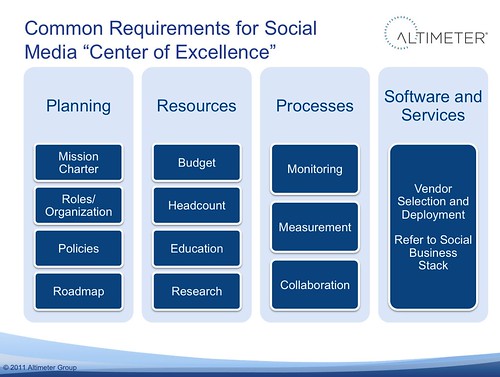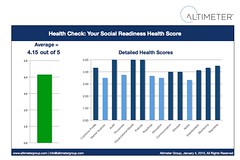Program Plan: The Social Media Center of Excellence
Definition: “Center of Excellence”
This is a program deployed by companies trending in the advanced levels of social business maturity. The Social Media Center of Excellence (CoE) is a centralized program that provides resources, training, and strategy to a variety of business units that are deploying social media in order to reduce costs, increase efficiency, and provide standardization. This team is often run by the Corporate Social Strategist, who’s the business stakeholder and program champion. To learn more, read the full research report on this role, and a list of these budding professionals.

The Social Media Center of Excellence has Four Major Duties: Planning, Resources, Processes and Vendor Selection and Management
Data: Companies Desire To Organize Social Media
Adoption by corporations only continues to rise. Business units can deploy their own efforts without the permission of corporate, whether they are ready or not.
- The third top priority of companies internally was to “Develop an Organizational model” said 34% of companies, reported 140 Corporate Social Strategists.
- Although there are five possible formations, currently, a majority of companies are situated in the Hub and Spoke model except for novice corporations who are in the centralized role.
- Staffing for these programs is the top spend against all programs, consuming $278,000 per average corporation is spent, out of the total of over $800k total annual spend.
Read more about budgets and headcounts in Altimeter’s report “How to spend on social business based on maturity”
Business Case for a Center Of Excellence
Corporations realize that social business is a horizontal function spanning all departments from: marketing, support, product, and supply chain, and must develop a centralized resource to serve the corporation, these programs provide the following benefits:
- Provide Customers With a Consistent Social Experience. Business units can either be coordinated in their efforts, or fragmented and decentralized, without a common program in place each business unit will develop their own programs resulting in wasted resources and a fragmented experience to customers.
- Obtain Efficiency Throughout the Organization. The cost will only increase as more business units develop social efforts on their own without proper “guardrails.” Secondly, this increases time-to-market by enabling various business units to communicate with each other.
- Foster Accountability Across Business Units. Corporations are saddled with hundreds of social assets which it is having difficulty tracking, let alone the risk of a single vendor selling multiple instances to various business units. This central group helps to sunset abandoned efforts and increase success of those in motion.
- Coordination Among Business Units. Companies needs processes and policies to handle negative situations and mitigate potential PR crises in social. This centralized group can quickly work with various arms of the company in a coordinated way to reduce risk, and increase responses to PR urgencies.
Case Examples
Corporations who are advanced at social business are likely to have a social media group in a centralized location that serves the rest of the corporation. The common name for this team is called Social Media “Center of Excellence” although there are quite a few variations of the theme. No surprise a majority of the examples we’ve found emerge from the first-to-adopt industry the technology space, here’s a few of note:
- Intel has one of the first groups to adorn the term Center of Excellence lead by Becky Brown, and serves as a dedicated team to a cross functional stakeholder group even within various Geos. They’ve trained thousands of employees through their program Digital IQ (available on the intranet), and keep teams up to date through an internal newsletter called “The Buzz”
- Adobe has launched a Center of Excellence in late 2009 by Maria Poveromo that adopted the Hub and Spoke model and includes cross-functional “social council” for cross functional sharing and support. This program provides governance, policies and guidelines, training, measurement support, and best practices including “guardrails”
- Dell has the Social Media and Communities (SMaC) team lead by Manish Mehta, that has one of the most advanced groups that has a physical listening station called the Social Media Command Center, and has a team responsible for global training, services, and software.
- Ebay has created a Center of Excellence that provides resources to both business functions like HR, Strategy, Platform, and Corporate Communicaitons, and also to geos and product units. They provide social strategy, alignment of roadmaps and plans, and analytics. They keep teams current through monthly social media council meetings. See this slideshare to learn more.
| Description |
This centralized group, often a corporate function provides services to business units for standardization, enablement and more. |
Spokes are business units that deploy social media on their own, once they’ve been properly trained and provided resources from the central team |
| Often located in: | The “Center of Excellence” is often located inside of the social media hub, which can also contain executive support. In some cases, the terms “Hub” and “CoE’ are interchangeable | The Business Units are often located in the “spokes” that can include product groups, business departments, and even regional groups. For example, SAP and Intel have social media leads in EMEA for those specific markets. |
| Primary Duties: | Set guidelines, policies and processes, and hold Spokes accountable. Provide and facilitate learning, education, and research in real time, reducing risk. May own listening tools, and distribute best practices. Report and coordinate with dotted line spokes, e.g. Executives, HR/Associates, Legal | Deploy social media efforts on their own, within established guidelines. Report and coordinate with Spoke on strategy, deployment, and measurements. Share best practices and learning to CoE and other business units |
| Limited to: | In the advanced corporations should be come an enabler to spokes –as they cannot manage all efforts. Should allow for regional and product level customization for programs |
Should not repeat efforts created by CoE, and work with centralized group for common measurements, process, vendors. |
Corporations Must Develop a Center of Excellence:
Follow These Three Steps to get your program started:
- First, start with anointing your open leader, the Corporate Social Strategist as the leader for this program. Learn more about this role in our research reports.
- Secondly, obtain an executive sponsor that will champion, defend, and fund this program as you build our your business case. Use principles from Open Leadership to help them maintain command when they give up control.
- Then, roll out the program in the following order to arrive in a Hub and Spoke model: Governance, Process, then an Education program.

Above: Altimeter offers the Social Readiness Roadmap which gets corporations prepared for social business internally by evaluating over 45 criteria. It provides a clear program plan to get ready, as well as recommendations for budgets, org models, headcount, ROI models, based on industry benchmark data.
